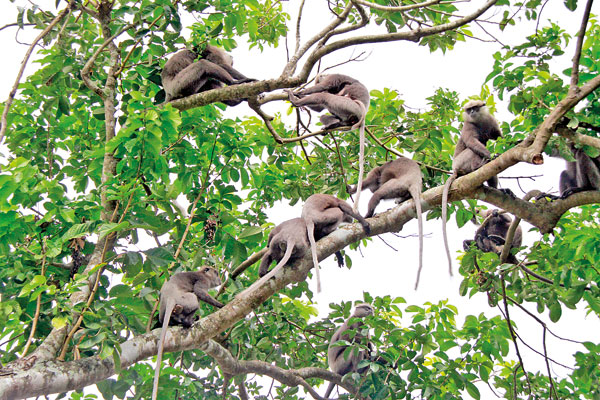News
Loss of habitat and lack of natural predators aggravating monkey issue, says expert Enclosed safari parks may be a solution
View(s):The monkey antics in certain areas of the country have reached a new level with much hostility from people.
Monkeys, mainly the rilawa (Macaca sinica or toque macaque) are raiding homes and pilfering stuff, damaging roofs, destroying crops and also biting people.
“Monkeys are not the only pests people have to deal with but also wild boar, giant squirrels and porcupines,” says the Director and Consultant Zoologist to China’s Chimelong Group Fauna and Flora Department, Vasantha Nugegoda, who has been requested by many to give his views on this subject.
To the query, why these animals have turned into home-garden raiders, he says that though this problem is not new, it has now become a serious issue.

Pic by Indika Handuwala
Vasantha has not studied the rilawa’s behaviour but worked with the Smithsonian Primate Survey Sri Lanka on Gray Langurs (Semnopithecus entellus) at Polonnaruwa, under senior Primatologist Prof. Susan Ripley in the 1970s. The late Dr. Charles Santiapillai had also been part of the team.
Recalling that at that time, Primatologist Prof. Wolfgang Dittus was studying the rilawa, Vasantha suggests that this expert’s views should be consulted on how to mitigate the human-monkey conflict as he has 50 years of experience in this field in Sri Lanka
According to Vasantha, unlike the Gray Langurs whose raids on home gardens were rare then, the rilawa is prepared to take risks.
Looking at his own village of Gohagoda, he says the population has increased and land fragmentation has taken place, with large tracts being divided into small blocks. Earlier, there were lush stretches, where wild animals could find a haven to rest and breed. With land clearance, the monkeys come in search of food including fruit into home gardens and to raid garbage bins which are not closed in urban areas which have hotels and restaurants. These foods, rich in protein, help them to breed throughout the year.
Humans have also contributed to the aggravation of the problem, says Vasantha, referring to interference in the natural eco-system resulting in global warming which has disrupted rainfall patterns and also feeding wild animals and not having monkey-proof garbage bins.
“Earlier there were no peafowls and giant squirrels in urban areas, but now they can be found in large numbers too because of loss of habitat, while the monkey issue has been aggravated by the lack of natural predators such as jackals, pythons, fishing cats and large water monitor lizards,” he points out, explaining that stray dogs are the culprits which have destroyed them.
Here are Vasantha’s suggestions to mitigate these problems:
· The control of stray dogs, as just sterilising them is not an answer, because the packs continue to roam the villages and attack the predators of the pests. To make matters worse, these dogs also attack farm animals such as chickens, goats and calves. Another danger is people being bitten by these strays, which then needs rabies vaccination at great cost.
To solve the issue of stray dogs, either the government or dog lovers should create a large fenced in area like a shelter to house them.
· Sterilisation of monkeys is good to some extent but is not a long-term solution. As the life-span of monkeys is about 20-25 years, the sterilised monkeys will still wreak havoc when they go in search of food.
To minimise the human-monkey conflict, the old methods do not seem to work – loud noises to chase them away, the use of catapults or even relocation. The latter also causes problems in the area they have been relocated to. Capturing and releasing these monkeys to an island is good if the authorities take the responsibility of feeding them and looking into their medical needs. The vegetation and fauna on such an island should also be considered, otherwise the monkeys would destroy all that, while the distance and depth of the water from the island to the mainland should also be factored in.
Another measure could be to capture them and release them into large enclosed areas such as safari parks which can be opened for locals and tourists as the largest toque monkey parks in the world. Giant squirrels and peafowls could also be introduced to these parks.
Criticisms that they would be monkey prisons would be unfounded if the animals are looked after well.
Vasantha warns that a conflict is brewing with the Gray and Purple Langurs and the need is to take early action to control them. He had made a request to the Central Province authorities a while ago to provide land to set up an Animal Rescue Centre but it had not become a reality due to a change in government.
He cites the Gannoruwa area, where according to a government Survey Plan, both sides of the river up to the main road have been declared a catchment area. However, small tourist attractions and stalls selling corn have mushroomed here. The fires of these kiosks spread along the road, preventing animals from accessing the river for water and feeding.
“If early action is not taken, this is a disaster waiting to happen,” says Vasantha, adding that all nature lovers should highlight the destruction of the natural habitat to help the authorities initiate action. (KH)
The best way to say that you found the home of your dreams is by finding it on Hitad.lk. We have listings for apartments for sale or rent in Sri Lanka, no matter what locale you're looking for! Whether you live in Colombo, Galle, Kandy, Matara, Jaffna and more - we've got them all!

